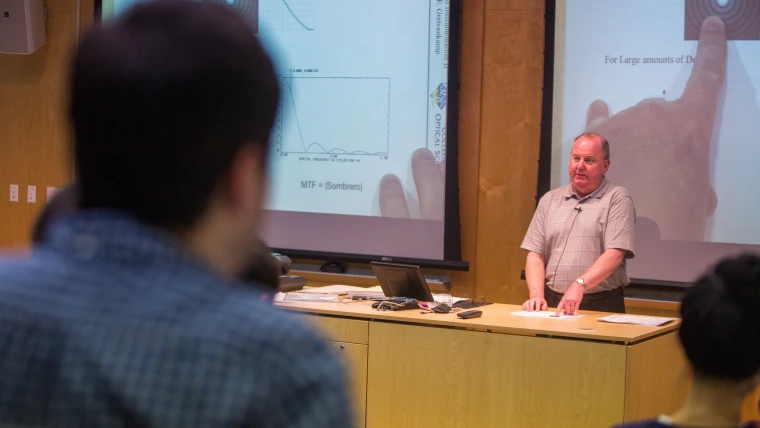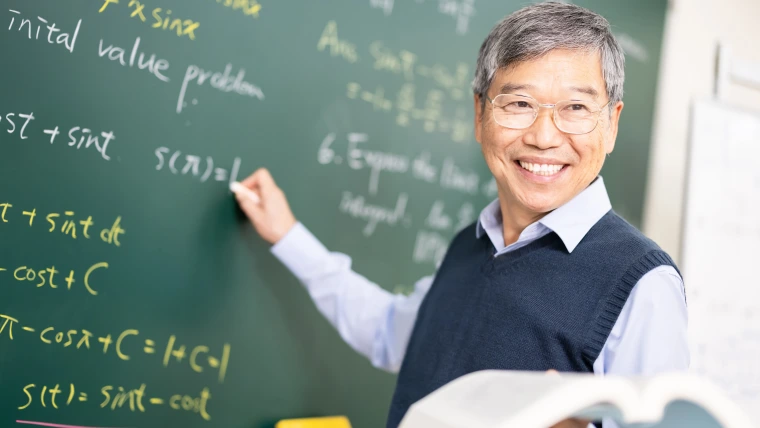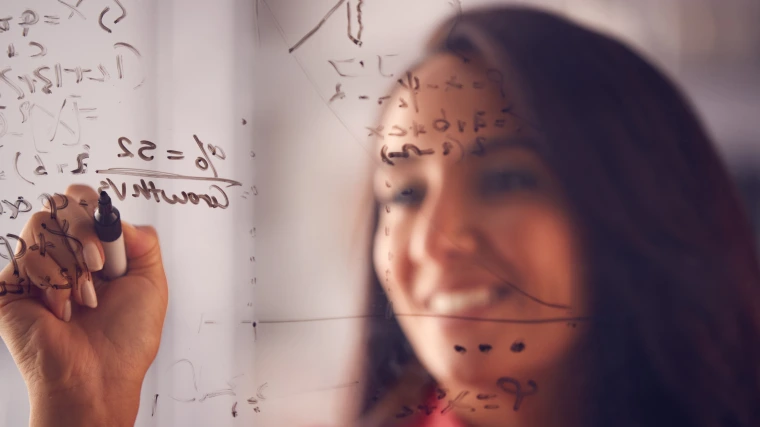
Research Topics
Below are lists of research topics currently being explored by members of our department.
Algebra and GeometryMembers of our department are doing research in:
Find out more below! |
Image

|
Our group focuses on the study of computational aspects of group theory. Moreover, GAP and in particular its databases for groups are used as an integral part of the graduate courses in order to give students hands-on experience with abstract algebraic concepts.
At the most basic level, group theory systematizes the broad notion of symmetry, whether of geometric objects, crystals, roots of equations, or a great variety of other examples. For example, the picture at the right is a buckyball, technically a truncated icosahedron. It is the familiar shape of a soccer ball, made up of regular pentagons and hexagons; it is also the shape of the carbon molecule C60, whose discoverers received the Nobel Prize for Chemistry in 1996. The group of rotational symmetries of the buckeyball is the alternating group Alt(5), with 60 elements. It is an interesting exercise to determine the axes of rotation of the symmetries and then to enumerate them. One way to do this in practice is to use the computer algebra system GAP (www.gap-system.org).
MEMBERS
Christopher Keller
Klaus M Lux
The research of the number theory group encompasses classical and algebraic number theory, computational number theory, and especially the modern subject of arithmetic geometry.
Arithmetic geometry is the study of number-theoretic problems informed by the insights of geometry—among them algebraic geometry, topology, differential geometry, and discrete geometries related to graph theory and group theory. Part of the appeal of the subject comes from its combination of easily stated problems (such as: Which integers are the sum of two squares or two cubes? How can one explicitly find all the solutions of an explicit polynomial equation in two variables? Are there positive integers (a,b,c) satisfying a^n+b^n=c^n when n>2?) and breathtaking applications of the latest technology from the mathematical frontiers. Another attraction is the phenomenal progress that has been made in the late 20th and early 21st century, including proofs of such landmark results as the Weil conjectures, the Mordell conjecture, and of course Fermat's last theorem. The number of Fields Medals (the mathematical equivalent of the Nobel prize) awarded for work in the area is a testament to its centrality in modern fundamental mathematics. On the other hand, recent applications of arithmetic geometry to communications protocols (such as strong cryptography and error correcting information transmission schemes) have brought the tools of the field to bear on crucial problems of Internet technology.
Two of the Millenium Prize Problems in mathematics, offered by the Clay Mathematics Institute, are in the area of number theory and one more is closely related to number theory.
MEMBERS
Bryden Cais
Sungyoon Cho
C. Douglas Haessig
Serin Hong
Kirti N Joshi
Daniel Madden
Anna Medvedovsky
William G McCallum
Robert Pollack
Douglas Ulmer
William Yslas Velez
Hang Xue
Pan Yan
Geometry is the study of figures in a space of a given number of dimensions and of a given type. Modern Geometry is a rapidly developing field, which vigorously interacts with other disciplines such as physics, analysis, biology, number theory, to name just a few. In recent years geometers encountered a significant number of groundbreaking results and fascinating applications. From progress in the Poincaré conjecture, geometric representation theory, quantization, to the mirror symmetry, string theory, applications in optics, biology, quantum computing — the ubiquity of geometry is impossible to overestimate. People in our group work in several important directions. We maintain strong contacts and collaboration with other groups in our department.
MEMBERS
Sergey Cherkis
David Glickenstein
Yi Hu
Anton Izosimov
Douglas M Pickrell
Douglas L Ulmer
|
Image

|
AnalysisMembers of our department are doing research in:
Find out more below! |
Problems in the Physical and Engineering Sciences have always provided a strong motivation for the development of many branches of Mathematical Analysis. For instance efforts to describe the motions of the planets led to the birth of Calculus and to the Theory of Differential Equations. Problems of Civil Engineering and Cartography gave rise to the Calculus of Variations and Differential Geometry. The needs of modern science continue to spur the development of analytical methods. The Department of Mathematics at the University of Arizona places a strong value on research that is both scientifically relevant and mathematically novel. The first and still most recognized journal of Nonlinear Science, Physica D, was founded in our Department. Today faculty are actively involved in research programs that address emerging theoretical needs in Microbiology, Materials Science, Photonics, Quantum Field Theory, Complex Fluids and Condensed Matter Physics. Our group organizes a weekly seminar to discuss new developments.
MEMBERS
Rossana Capuani
Sergey Cherkis
Maria Deliyianni
Nicholas M Ercolani
Ibrahim Fatulkin
Leonid Friedlander
Karl B Glasner
David Glickenstein
Christopher Henderson
Leonid Kunyansky
Joceline C Lega
Roberto S Maier
Alan C Newell
Tonatiuh Sanchez-Vizuet
Sunder Sethuraman
Patrick Shipman
Megan Stone
Shankar Venkataramani
Weinan Wang
Lay May Yeap
Dynamical systems is the branch of mathematics devoted to the study of systems governed by a consistent set of laws over time such as difference and differential equations. The emphasis of dynamical systems is the understanding of geometrical properties of trajectories and long term behavior. Over the last 40 years, with the discovery of chaos and strange attractors, dynamical systems theory has gained considerable interest and has been found to have tentacular connections with many different areas of mathematics (such as number theory and topology) and science. Dynamical systems can model an incredible range of behavior such as the motion of planets in the solar systems, the way diseases spread in a population, the shape and growth of plants, the interaction of optical pulses, or the processes that regulate electronic circuits and heart beats.
As an example, consider the dynamics of celestial bodies such as planets, stars, or galaxies. What is the long-term dynamics of planets around the sun, or stars in a galaxies? Do they exhibit regular and predictable behavior? Or would their motion eventually become chaotic and unpredictable? Could planets in our solar system be ejected, or collide with each other? The mathematical answers to these fundamental questions lie in the analysis of the Newton's equation for the motion of n bodies in gravitational interaction. These equations form a set of differential equations that can be analyzed by the methods of dynamical systems theory.
Our department of Mathematics as a long tradition in dynamical systems both from a pure and applied perspectives and many members of our department are actively engaged in research in a host of different projects with many interdisciplinary components.
MEMBERS
Jim Michael Cushing
Anton Izosimov
Kevin Lin
Rongchang Liu
Marek Rychlik
Patrick Shipman
Shankar Venkataramani
Qui-don Wang
The research area of Geometric Analysis historically has grown out of the study of calculus and differential equations involving curves and surfaces or domains with curved boundaries. This has been the origin of many mathematical disciplines such as Differential Geometry, Lie Group Theory and the Calculus of Variations, which are subareas of Geometric Analysis. The development of techniques to handle the mathematical intricacies of doing analysis on manifolds (the higher dimensional and intrinsic analogues of curves, surfaces and domains) is fundamental to much of Engineering and Physics. It is therefore not surprising that much of the impetus for current research in Geometric Analysis comes from these disciplines. Physics in particular, through theoretical developments in relativity theory, quantum mechanics and string theory, has spurred many exciting new research directions in geometric analysis. For instance, as a consequence of these motivations, tremendous progress has been made on topological classification problems for manifolds.
Problems in Applied Mathematics or Engineering can also give rise to deep and fascinating geometric questions. An example is the following: by carefully listening to a drum being played can you reconstruct the drum? More specifically do the characteristic frequencies found in a Fourier decomposition of the sounds coming from the drum allow you to mathematically recover the particulars of the drum. Mark Kac put it succinctly, "Can you hear the shape of a drum"? One can pose a similar inverse problem on a general Riemannian manifold, which is a manifold endowed with a local metric (distance function); namely, from a knowledge of the frequencies of the standing solutions of the wave equation on a Riemannian manifold, how much of the manifold and its metrical properties can one recover?
This kind of broad interplay between physical motivations, geometric reasoning and various analytical methods is characteristic of the activities of our faculty and graduate students doing research in Geometric Analysis.
MEMBERS
Sergey Cherkis
Sunhi Choi
Nicholas M Ercolani
Leonid Friedlander
David Glickenstein
Douglas M Pickrell
Shankar Venkataramani
Mathematics and physics have interacted fruitfully for centuries. Physics has been a constant source of interesting mathematical problems, and these problems have often required new mathematics for their solution. Conversely, advances in mathematics have found surprising and impressive applications in physics.
Research in mathematical physics at the University of Arizona centers around the areas of classical and quantum statistical mechanics, quantum field theory, and random or disordered systems. Some specific topics include spin glasses, quantum electronic systems, solvable models, percolation, random matrices, and localization. The mathematics involved in this research comes from analysis, probability and geometry.
MEMBERS
Sergey Cherkis
William G Faris
Ibrahim Fatkullin
Christopher Henderson
Anton Izosimov
Christoph Keller
Tom Kennedy
Robert S Maier
Douglas M Pickrell
Sunder Sethuraman
Robert Sims
Megan Stone
Weinan Wang
Jan Wehr
Applied MathematicsMembers of our department are doing research in:
Find out more below! |
Image

|
Computation is now regarded as an equal and indispensable partner, along with theory and experiment, in the advance of scientific knowledge and engineering practice. Numerical simulation enables the study of complex systems and natural phenomena that would be too expensive or dangerous, or even impossible, to study by direct experimentation. The quest for ever higher levels of detail and realism in such simulations requires enormous computational capacity, and has provided the impetus for dramatic breakthroughs in computer algorithms and architectures. Due to these advances, computational scientists and engineers can now solve large-scale problems that were once thought intractable.
Computational science and engineering (CSE) is a rapidly growing multidisciplinary area with connections to the sciences, engineering, mathematics and computer science. CSE focuses on the development of problem-solving methodologies and robust tools for the solution of scientific and engineering problems.
(quoted from "Graduate Education for Computational Science and Engineering" prepared by the SIAM Working Group on CSE Education.)
MEMBERS
Moysey Brio
Karl B Glasner
Lisa Marie Imbert-Gerard
Rob Indik
Leonid Kunyansky
Joceline C Lego
Kevin Lin
Frederic Marazzato
Marek Rychlik
Tonatiuh Sanchez-Vizuet
Misha Stepanov
Our research in Fluid Mechanics is concerned with fluid mixing and turbulence, large scale oceanic flows in the form of climate dynamics, astrophysical flows and waves; and small scale flows, such as those that occur at scales relevant to industrial coatings and biological fluids such as blood. In the area of mechanics we study the dynamics of filaments, and rods, plates and shells, all important in biology and in engineering.
MEMBERS
Bruce Bayly
Oussama Ben Said
Karl B Glasner
Christopher Henderson
Anton Izosimov
Rongchang Liu
Laura Miller
Alan C Newell
Michael Tabor
Shankar Venkataramani
Weinan Wang
Significant interactions between mathematics and biology began at least a century ago in population dynamics models. Today, mathematical ecology and population biology represents the confluence of two great traditions, one originating with the work of Lotka and Volterra in their study of population dynamics, and a second developed by Haldane, Fisher, and Wright to study the mechanisms of inheritance.
We have similar foundational contributions from mathematics to a variety of areas in biology: Poiseuille's Law for blood flow, the Hodgkin-Huxley model for electrophysiology, the Michaelis-Menten relation for enzyme kinetics, and the Berg and Brown model for bacterial chemotaxis are just four of many possible examples.
Powerful new techniques in molecular biology, physiology, genetics, and ecology are taking biology into a much more quantitative era. As mathemticians analyze the increasing volume of data and model increasingly more intricate biological phenomenon, we are seeing more and more how mathematics is a unifying force in biology.
Thus modern biology is calling upon a team of experts in order to continue to keep pace with the vast array of quantity information from the field and from the laboratory. Today, mathematicians with expertise as diverse as non-linear partial differential equations, dynamical systems, probability, statisitics and stochastic processes, combinatorial mathematics, graphs and networks, and low dimensional topology are engaged in this broad endeavor.
MEMBERS
Jim Michael Cushing
Christopher Henderson
Joceline C Lega
Kevin Lin
Laura Miller
Timothy Secomb
Patrick Shipman
Michael Tabor
Joe Watkins
The study of Nonlinear Wave Phenomena is of broad scientific interest. It pertains to the understanding of real water waves, the interaction of light with matter, optical fiber transmission, traffic flow, earthquakes and galaxy formation. As a modern mathematical discipline nonlinear wave theory frequently explores asymptotic regimes (such as varying over many scales, high frequency or large amplitude) which are not easily accessible via numerical simulations. Faculty at Arizona have pioneered many of these explorations which include the description and analysis of solitary waves and their stability, zero-dispersion limits of integrable wave equations, blow-up in the nonlinear Schrödinger equation, ultra-short laser pulses, dispersion management of optical solitons, spatio-temporal chaos and wave turbulence. This continues to be a very active area of research within our Department.
MEMBERS
Sergey Cherkis
Nicholas M Ercolani
Ildar R Gabitov
Rob Indik
Joecline C Lega
Jerome V Moloney
Alan C Newell
Nonlinear Optics and photonics have attained a special status at Arizona. The study of propagation of light pulses in nonlinear optical media is of great technological interest. It also leads to some beautiful and sophisticated mathematics. One of the areas that is currently actively studied is nanophotonics. It is a rapidly developing new area of science of great importance for technology and basic science. It is based on new materials incorporating inclusions of nanoscale size. These materials do not exist in nature and they display exotic properties which can be used for design of new optical devices with superb characteristics.
The exceptional multidisciplinary culture provides a unique environment for collaborative research with colleagues at the Optical Sciences Center, Program in Applied Mathematics, Arizona Center for Mathematical Sciences and Mathematics Department. Graduate students in Applied Mathematics, Optical Sciences and Physics work together on research projects at the frontiers of this exciting field. Tucson's designation as "Optics Valley", reflects the large concentration of Optics industries in the region and provides a strong industrial link to the University of Arizona. There are several ongoing weekly seminars in addition to regular departmental colloquia.
Optical Science Website (Under Construction)
MEMBERS
Moysey Brio
Ildar R Gabitov
Rob Indik
Jerome V Moloney
Alan C Newell
Image

| Mathematics EducationMembers of our department are doing research in:
Find out more below! |
The Mathematics Education group is involved in creative scholarly activities, oversees the Department's teacher preparation course (including an innovative secondary teacher preparation program), and carries out an array of outreach projects for school-age students, teachers, and parents. The Mathematics Education group maintains a strong program of research and scholarly productivity. They have produced innovative, nationally published texts for college students as well as a series of nationally available K-8 mathematics texts. In research, the group focuses on teacher education and on issues of equity and diversity in the teaching and learning of mathematics, primarily within a socio-cultural framework. There is also an increasing interest in research in mathematics education at the undergraduate level. The creation in 1992 of a mathematics education option in the department's Ph.D. program and a teaching option in the MA program complement these research activities. There is currently a Mathematics Education Research colloquium that serves as a forum for discussion for graduate students and faculty working in this area.
MEMBERS
Adi Adiredja
Cynthia Anhalt
Bruce Bayly
Marta Civil
David A Gay
Guadalupe Lozano
William G McCallum
Rebecca McGraw
Jennifer A Wolfe
Faculty in the University of Arizona Mathematics Department are actively engaged in activities to improve the quality of undergraduate mathematics education, both in the mathematics community at large and at the University of Arizona.
MEMBERS
Adi Adiredja
Brenae Bailey
Carl L Devito
Deborah J Hughs Hallett
Rob Indik
Theodore W Laetsch
Joceline C Lega
Guadalupe I Lozano
Daniel Madden
William G McCallum
Rebecca McGraw
Richard B Thompson
Elias Toubassi
William Yslas Velez
Jennifer A Wolfe
Probability/StatisticsMembers of our department are doing research in:
Find out more below! |
Image

|
Probability is a mathematical theory of random events and random variables. It even extends to random functions of time (stochastic processes). Probability models occur in almost all areas of science: biology (genetics, epidemiology), economics (financial markets), physics (diffusion, theories of molecular matter), and so on, and it is essential for many statistical techniques. Relatively simple probability principles lead to astonishing results. One that has been famous for centuries is the Gaussian or normal curve (the bell-shaped curve). It is an almost universal solution to problems involving independence or weak dependence. Are there similar universal principles for strong dependence? Can these principles be applied to random functions of space? Or even to quantum fields and the structure of elementary particles? Such questions are at the forefront of current research.
Several of the people active in probability are also involved with mathematical biology, mathematical physics, or mathematical economics.
MEMBERS
Rabindra N Bhattacharya
Michael Conroy
William G Faris
Tom Kennedy
Rongchang Liu
Robert S Maier
Yashaswini D Mittal
Donald E Myers
Sunder Sethuraman
Joe Watkins
Jan Wehr
The field of statistics is concerned with ways of understanding variability in measurements. It is the science and art of making informed decisions in the face of uncertainty. There is a close connection with probability, since probability provides the mathematical language to describe uncertainty.
The statistician today is a partner in most scientific and technologic endeavors. There are medical issues: to decide whether a new vaccine will be effective; to appraise the cost of life insurance for middle age smokers; to resolve and sharpen images obtained by ultrasonography. There are also technological applications: to gauge the uniformity of an optical fiber; to assess the reliability of a jet engine; to guide the exploration of ore deposits. The influence of the statistician extends to many other areas, from public policy to fundamental science.
Identifying and understanding important applications requires interaction with other disciplines that acquire and analyze data. The Department of Mathematics is thus cooperating with an university-wide Graduate Interdisciplinary Program in Statistics to provide support for statistics at the University of Arizona. Recent activities include a well-attended statistics colloquium series.
MEMBERS
Rabindra N Bhattacharya
William G Faris
Ning Hao
Robert S Maier
Yashaswini D Mittal
Donald E Myers
Selena Niu
Walt Piegorsh
Marek Rychlik
Henry Scharf
Xueying Tang
Joe Watkins
Helen Zhang

